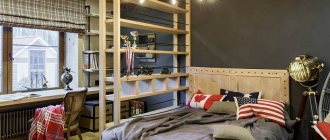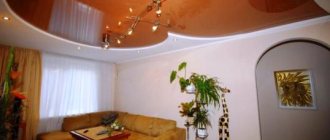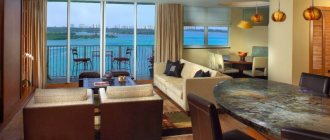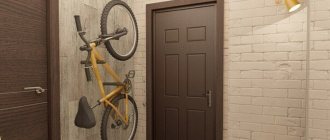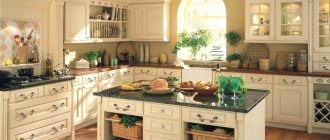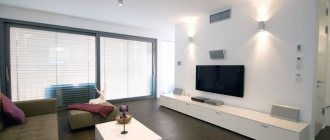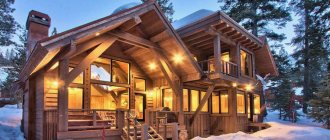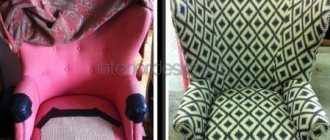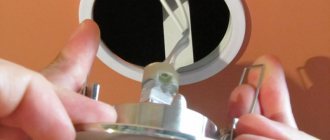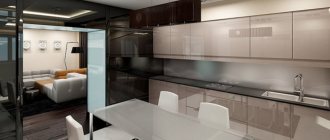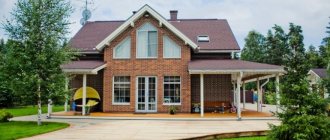The coffered ceiling is a polygonal structure with recesses, eye-catching cells and beams.
The coffered ceiling is also called lacunar, which means “recess” in Latin, and decorative, since it meets all the requirements of modern design regarding the elegance of the existing elements.
Coffered ceilings occupied their niche in the interior back in the days of ancient Greece, but then coffered ceilings had a completely different purpose.
Their use made it possible to reduce the weight of the floor slabs, and thereby eliminate unnecessary load on the beams.
To prevent the coffered surface from spoiling the overall design of the interior of the room, its protruding elements were decorated with stucco molding and drawings.
At the moment, the coffered structure is considered one of the exclusive options for the architectural design of the ceiling surface.
Its use provides a chance to transform an ordinary room into a space shining with luxury.
Photo:
The production of a coffered ceiling in the interior is based not only on compliance with a certain installation technology, but also on thinking through every detail of their designs.
The chic surface above the head is created through a variety of stencil painting and gilding, moldings, ornaments and appliqués.
Coffered ceilings in interiors
The design of the lacunar ceiling, even to an inexperienced person in the field of design, suggests with its entire appearance that it would be appropriate only in rooms with high surfaces.
Rooms with small areas, if the most original ceiling flaunts overhead, will not allow you to emphasize its exclusivity.
The coffered design, as can be seen from the photo, proves its effectiveness in rooms with a ceiling height of at least 2.5 m.
At the same time, a lacunar ceiling (including one made of polyurethane) can be installed in any space of a living room, in a living room, bedroom or study, billiard room or office.
In addition, a lacunar surface in a classic style is an excellent solution for decorating a country cottage or home, where its use will create not only an attractive design, but also impeccable acoustics.
DIY coffered ceiling
Coffered ceilings have received a rebirth in our time. It cannot be said that caissons in modern architecture serve as a load-bearing structure, but they have actually been used as a decorative element in modern interior design for a very long time. You can see in many historical films, along with luxurious ancient castles, ceiling cassettes of a certain configuration and carved wooden beams that form peculiar cells and rectangular sections. Well, let's try to revive coffered ceilings of extraordinary beauty at home?
Features of coffered ceilings
A coffered (lacunar) ceiling is a special type of ceiling that consists of recesses, beams and cells (“caisson” is a polygonal recess). Such ceilings are also called decorative. As for caissons, they can be not only square, but also round. Among the caissons, transverse and longitudinal beams with ornaments, molded rosettes, cornices, borders, profiled transitions to the walls, and paintings on the ceiling surface are known.
Coffered ceilings were invented in Ancient Greece. At that time, they performed more of a practical function than a decorative one - they reduced the mass of the slabs, thereby allowing the excess load to be removed from the beams. For beauty, they were simply decorated with drawings and modeling. This technology is very ancient. This is evidenced by the findings of archaeologists found during excavations of the necropolis, when ceilings of this type were discovered, dating back to the 7th century BC. e. During the Renaissance, wooden coffered ceilings were popular. Then they decorated palaces.
Coffered ceilings can undoubtedly give an impressive look to any room, be it a living room, bedroom, office, billiard room or library. This type of ceiling decoration is also appropriate in a prestigious office, because it expresses the power and status of the company. In addition, the coffered ceiling looks great in a country house or cottage decorated in a classic style. Such a ceiling allows you to make the structure lighter and create good acoustics.
Most often, this technique is used in rooms with high ceilings, where the impression of a huge space is created. Coffered ceilings are made in rooms whose height is at least 2.5 meters. In small rooms such a ceiling will not look impressive enough. The architectural style should also be taken into account, but if you like to experiment and create something new, you can choose coffers of different shapes and styles (but, of course, styles such as hi-tech and pop art do not allow such ceiling designs).
Coffered ceilings are an excellent solution for old-type buildings whose wall heights are close to 3 meters. However, in this case, another problem arises: sometimes you want to move, lower the ceiling so that the room gets the correct proportions, and the person does not feel locked in a huge box. Decorative wooden slabs of brown color, as in the photo of coffered ceilings, will come to the rescue.
Coffered ceilings can be used not only for arranging a ceiling vault, but also for decorating the internal surfaces of arches. The design of coffered ceilings skillfully hides the unevenness of the existing load-bearing floors and eliminates the need to level the surface before finishing. Using this ceiling design, it will be easy to hide ventilation ducts, air conditioning system pipes and electrical wiring to the lamps. The ceilings are ideal in terms of geometry and protected from various types of deformations.
Types of coffered ceilings
When renovating their apartment, few people think about the fact that the technologies and techniques widely used today have an ancient history and were invented a long time ago. A coffered ceiling is one such technique. This interesting technique allows you to make your home original and cozy; in addition, it has a rich history. Coffered ceilings in their essence are a type of favorite suspended ceilings, which are already somewhat tired and have lost their relevance.
Wooden coffered ceilings
Coffered wood ceilings are very practical and beautiful. They look rich and unusual, creating the impression of luxury and comfort in your home. Wood is an environmentally friendly natural material that you can use when making repairs and not worry about the health of those close to you. Basically, walnut, ash, oak, and sometimes materials that are much more expensive than those listed above are used to make coffered ceilings. An unusual design is also created due to the fact that the natural pattern of the tree itself is always very beautiful and unique in itself, its texture is inimitable.
Such a ceiling will hide uneven ceilings (or the ventilation system) and serve as a unique decoration for the room. But the price of coffered wooden ceilings is very high and depends on the type of wood and the complexity of the work. And if you have chosen inexpensive wood for the ceiling, then you can add expressiveness to the texture and reveal its beauty even more by applying varnish or stain to the cassettes, lining or panels. It is this treatment that will give the most inexpensive types of wood an impressive and elite look.
Coffered MDF ceiling
A coffered ceiling made of MDF panels is the cheapest design, but at the same time it is an excellent alternative to natural wood. If you handle MDF panels correctly, you will get an unsurpassed and luxurious result.
Another advantage is ease of installation, which cannot be said about wooden cassettes. However, MDF panels have such negative qualities as exposure to moisture, high flammability and low resistance to mechanical damage and deformation.
Coffered plasterboard ceiling
A plasterboard coffered ceiling is a cheaper option that will allow you to save your budget (do not confuse it with a plaster ceiling, because it involves hand-sculpting on the surface). This type of ceiling is suitable for you if your home is decorated in Empire, Baroque styles and has large windows and high ceilings. A coffered plasterboard ceiling implies that a frame will be made from plasterboard, which can be decorated with a plaster cornice.
You can also provide sockets as additional decorative material. It is also convenient to sew a lighting system into such a ceiling. There is another technique for creating such a ceiling - the absence of a frame, but the caissons are made of plasterboard, all parts of the ceiling need to be joined like a puzzle so closely that the structure looks solid and complete.
Coffered ceilings made of polyurethane
Coffered polyurethane ceilings are used primarily for decorative purposes. They are very light, which cannot be said about wooden structures, but they are also a little more expensive. Caissons can be manufactured to specific dimensions to eliminate costly cutting and speed up the installation process.
Polyurethane caissons with properly selected and positioned lighting will look very chic. Also, these products have gained popularity due to the symmetry of all cassettes, the ease of giving them the desired shade, and high moisture and fire resistant properties.
Cardboard coffered ceilings
Coffered ceilings made from building cardboard are also widely used. Beams are usually glued with wood glue; you can cover them with self-adhesive film, which imitates some kind of texture (wood, for example). But you need to glue it when the ceiling is ready, that is, when all the beams are glued.
DIY coffered ceiling
If you do not want to entrust such work to professionals, you can make a coffered ceiling with your own hands, carefully following the instructions and all directions.
Preparatory stage
Remember again that coffered ceilings cannot be installed in all modern houses, because such a design in houses with low ceilings will be superfluous and even more completely inappropriate. The ceiling height in the house should be at least 2.5 meters, then you will have a chance to experiment.
But if you have a great desire to create such a ceiling in your apartment, and the height of the ceiling leaves much to be desired, you can still take a risk, but choose thin panels and always light colors. When working on a coffered ceiling, follow the general rule: the more spacious the room, the more beams you should use to decorate it. For work, standard planks are usually used, which have a height and width of 12-15 centimeters, although it is necessary to take into account the height of the ceilings and the overall dimensions of the room.
Beams in apartments with low ceilings should be placed in the openings of doors and windows, which creates a visual contrast with the existing recesses and thereby “spreads apart” the space. Remember that it is not recommended to install coffered ceilings in rooms with dark furniture and poor lighting, as they can create a depressing, unpleasant environment.
It is also important to remember some secrets of installing a coffered ceiling. For example, if you chose white and decided to move the ceiling down a few centimeters, you risk creating an unusual effect that the ceiling falls on your head. Be careful and attentive when choosing the color of your future ceiling. If you need to make a room smaller and cozier, go for brown, it will help create warmth and harmony.
Think about the composition. You can buy wallpaper with beautiful patterns or create stucco decorations. You can use applique and stencil painting, stick on flowers and architectural details. It is better to make the center of the ceiling more elegant and bright.
Materials for work
First, draw a sketch and decide on the composition of the future ceiling. Don't forget to consider the height of your home's ceilings and interior decor. Everything should be harmonious and neat. To determine how much material you need to create a coffered ceiling, find the center of the room and create a preliminary drawing, drawing out the locations of the tiles.
When going to the store to buy materials, take the drawing with you. Remember that you need to carefully select wallpaper for the ceiling - it can be very simple, or you can choose wallpaper with a pattern, the main thing is that everything matches. But the most win-win option is light wallpaper, which is glued before arranging the ceiling.
First of all, you need to buy blanks from which you will create the coffered ceiling structure. The easiest option in creating a coffered ceiling would be to purchase ready-made individual squares (modules that will play the role of coffered ceilings), which are glued to the ceiling. Over time, of course, they can come off, and this is a big disadvantage of this option. The pitch of the caissons should be approximately 80 to 100 centimeters for a standard ceiling height.
To create a coffered ceiling in front rooms, pine or other natural wood is most often used; chipboard is also suitable for the ceilings of residential apartments, which is easier to use and process. Such material, which will be additionally upholstered with natural veneer made of beech, spruce or oak, will acquire a bright texture and an attractive appearance. In addition to wood and light wallpaper, you will need adhesive paint, high-quality wood glue, nails, a saw, a square and an accurate ruler.
Frame made of support beams
For greater reliability of fixing materials, it is necessary to prime the surface of the ceiling. If the primer is absorbed very strongly, then you should cover the surface with another layer after drying. It is recommended to glue wallpaper under coffered ceilings. Choose a pattern with a slight structure or a solid color. It is better to glue the wallpaper together; smooth it using a special plastic spatula.
To begin, create marks on the ceiling surface along which you will apply the lattice structure. First, decide on the location of the central strip, which, depending on the configuration of the space, runs in the middle of the ceiling or deviates slightly to the side.
The main detail of a coffered ceiling is the support beams, which have a complex box-like structure: they are nailed to the ceiling in a certain order, creating an ornament. Having decided on the location of the main part of the coffered wooden ceiling, you should begin making box-shaped beams: cut a plank along the length of the ceiling, on the sides of which small planks are nailed at equal distances.
Then attach the assembled frame to the ceiling with nails, carefully checking the design plan. After this, it is recommended to measure the dimensions and cut the strips that will cover the sides of the structure. Finish the frame by covering it from the bottom with a board that fits snugly. Nails are most often used to fasten the component parts of a coffered ceiling structure, but you can also connect small fragments with wood glue. The main thing is to choose reliable brands and strictly follow the instructions for its use.
Next, make box beams and place them parallel to the central structure, according to the developed sketch. When all the longitudinal strips are attached to the ceiling, it is necessary to proceed to the installation of transverse structures; work on this requires a lot of attention. Apply them strictly according to the marked marks; attach special importance to the processing of corners that are adjacent to the longitudinal parts of the grille. Wooden coffered ceilings will look solid and festive only with careful processing of the component parts.
To process cracks, you can also use thin profile slats, which are used in different ways, but in any case they add new expressive accents to the design of your home. In addition, you have several more surface finishing options. You can completely cover an already installed coffered ceiling with paint. The structure can also be painted partially or with several paints of different colors. In addition, specially designed film can be used for this purpose.
Gluing finished boards
If you are working with ready-made tiles so that the patterns and designs come out beautiful and even, attach the first tile in the center of the room, this will make it easier for you to navigate. It is necessary to glue the ceiling caissons using assembly glue; at this time it is important not to stain the wallpaper. Check the proportionality of the corners of your room. If any angle is incorrect, fasten the caisson by retreating a few centimeters. You can draw lines on the ceiling where the beams will be placed. Secure the slabs with brackets, and their connection with insert tenons.
Insert cleats will not be strong or reliable enough. For complete fixation, purchase decorative slats. They need to be inserted into the cracks between the plates. It is best to choose double slats. The thickness of the slats that will run along the walls should cover all indents and imperfections. This will help the room acquire the desired features. If you use gypsum elements in your work, fasten them with self-tapping screws, and for cardboard beams use construction glue.
Now you know how to make a coffered ceiling! Having created such a design with your own hands, you will understand many of the subtleties of this fascinating process and learn how to create unique ornaments - elements of the decor of your home. The presence of created beams and moldings plays an exclusively decorative role, however, like the entire coffered ceiling, because in modern houses its practical function recedes into the background.
Coffered ceiling made of wooden elements
A coffered ceiling made of wood can be considered an ideal design option for a space in a classic style.
You can entrust the development of a project for the arrangement of caissons in the chosen style to the hands of specialists or do it yourself.
Wooden coffered ceilings should be made taking into account the future location of the furniture, the amount of daylight and artificial lighting.
Of course, special attention is paid to the choice of the color of the wood used to create them, or the shade of paint used to cover it.
When ordering wooden elements of a coffered ceiling in a workshop, you must indicate the expected height of the coffered profiles.
If possible, it is recommended to order a sample to test one, in your opinion, significant detail. This will ensure that you make the right choice.
Pay attention to the photo; after the installation of the ceiling is completed, its design will please you with the successful arrangement of panels, beams and beams.
Coffered combined ceiling made of MDF
The technique of creating a coffered ceiling with MDF elements is similar to the construction of a wooden covering, the difference is that in some areas of the plane, instead of solid wood, sheets of fiberboard are used.
Despite the fact that MDF boards have a lower value compared to natural wood.
Their technical characteristics are much higher than natural materials, and are more than suitable for creating this type of ceiling. Unlike wood, slabs do not dry out or become deformed.
By the way, in fact, if you judge from the photo the appearance of coffered ceilings with elements of wood fiber boards, then at a casual glance it will be difficult to immediately say what exactly they are made of.
Is it a combined system, or is it completely made from natural material?
Lacunar ceiling made of plasterboard and molding
A coffered ceiling made of plasterboard or polyurethane is a budget option for decorating the ceiling surface.
But at the same time, a ceiling made of polyurethane or plasterboard is considered the most difficult to execute among the structures we are considering.
A competent approach to developing a design project and the correct use of products will allow you to achieve the desired result and make a coffered structure made of polyurethane or plasterboard in a certain style.
By combining these two main facts, you can get a more refined texture from polyurethane and plasterboard than when making coffered ceilings from expensive natural materials.
In the photo below you can see what a coffered ceiling made of plasterboard and polyurethane looks like in the interior.
Photo:
Based on the foregoing, we can conclude that the general principle of creating coffered structures is to make figured projections on the ceiling from plasterboard and to create recesses (niches), which are subsequently decorated with moldings.
Kinds
Coffered ceilings are essentially a type of suspended structures, which in their traditional form, I must say, are a little tired of consumers. This same finishing method will bring something new to the design of your home.
Such decorative finishing always looks “rich”, and if the entire decoration of the room matches the ceiling, the interior will look breathtaking.
Cardboard version
The cheapest option is considered to be a design in which the ceiling decorative elements are made of construction cardboard. They can be mounted either on a base ceiling or on a pre-installed suspension system.
After installing all the elements, the coffered ceilings can be painted with water-based paint, or each component of the constructor can be covered with a self-adhesive film, with a wood texture, for example.
Plasterboard option
A coffered plasterboard ceiling will cost a little more. This method cannot be arranged without a frame.
This option will look good in rooms with large windows and massive doors. This finishing involves the use of decorative elements that decorate and complement the finished ceiling. Such as, for example, gypsum or polyurethane cornice.[adsp-pro-25]
Drywall allows you to easily use the lighting system inside the caissons, which gives the structure a special, unique style.
Coffered ceiling made of MDF
MDF panels and cassettes are probably the best alternative to similar wooden parts. With an appearance that imitates the best examples of valuable wood, they have less weight, and accordingly, place less load on the suspended frame.
Using this material you can produce coffered ceilings of unsurpassed beauty.
But every barrel of honey has its own fly in the ointment. There are no building materials without flaws. MDF also has disadvantages.
MDF ceilings are not moisture resistant, have a low threshold of resistance to mechanical stress, and most importantly do not meet fire safety requirements due to their high flammability.
Coffered ceilings made of polyurethane
This material, unlike its predecessor, has excellent resistance to moisture and fire. During the production of polyurethane cassettes, the manufacturer can give them any color and shade. With the same ease and ease, any design or pattern can be created on the surface of the cassettes.
The biggest advantage over other materials that polyurethane ceiling parts have is in the area of dimensional compliance. It is almost impossible to get gaps between the cassettes, provided that they are assembled correctly.
Wooden coffered ceilings
A wooden ceiling will look the most beautiful, the most elegant. And if the caissons on the ceiling are made of valuable wood, this will further refine the surface above your head.
Wood is a natural, environmentally friendly building material for your apartment. By using wood to construct coffered ceilings, you can be sure that your household is reliably protected from the effects of harmful substances that are simply not present in this material.
A wonderful, unique look is created by the wood itself, due to the patterns and patterns of the cut. This means that the ceiling will be exclusive, which is important for some people.
This finish, accordingly, is the most expensive of those listed above. Such decor overhead obliges the owner to decorate the entire room accordingly.
We think that very soon we will be able to please you with a publication on the topic “Do-it-yourself coffered ceilings,” but we can say one thing right now.
There is nothing particularly complicated in the installation process and any man who, as a child, held at least a metal construction set in his hands can do it.
How to build a lacunar ceiling yourself
It is quite difficult to make a coffered ceiling with your own hands, but the use of ready-made modules and the proposed photos will make the process easier.
To create a coffered surface you will need:
- ready-made caissons - can be purchased at a hardware store;
- standard slats for beams (width 12-15 cm);
- wood adhesive;
- hacksaw, nails, hammer;
- meter and square.
Step-by-step arrangement of a coffered surface:
- The ceiling base surface is primed, then covered with light wallpaper. The material is taken in a single color or with a fine pattern structure;
- The places where the lattice frame made of wooden slats will be mounted are marked on the ceiling; to do this, it is necessary to determine the location of the central rail. The surface should be marked in such a way that the outermost square element has a distance (for the frieze) from the wall of 15-25 cm;
- Next, the support beams are installed; they are also the main parts of the ceiling. Fastening the beams in a certain order allows you to create the desired ornament;
- Beams are attached along the perimeter of the ceiling. For the correct positioning of the remaining beams, stretched twine is used;
- The panels are fixed to the beams with brackets, each square is secured with nails.
The general installation technology consists of first fixing the longitudinal strips, then the transverse parts.
Video:
If desired, the surface is decorated with a special film or painted.
Finished slabs are installed according to the following action plan:
- The first slab is installed in the center using special metal brackets. The bracket is mounted in one recess of the caisson, in its second groove, on the other hand, a mounting strip is installed;
- Then the ratio of the angles is checked and the installation of the caissons continues using embedded strips. This is how the entire ceiling plane is arranged. Short elements are fixed in one direction, long ones are positioned and secured perpendicular to the short elements;
- A frieze is installed in the gaps along the walls and decorated with decorative slats.
Types and installation of coffered ceilings
The fashion for coffered ceilings arose several centuries ago, but now their function has changed. Nowadays, wooden beams are intended more for visual decoration than to strengthen the structure of the house. In addition, if previously only high-ranking officials could afford such a luxury, now everyone has the opportunity to make a coffered ceiling at home with their own hands.
